
unsung heroes
![]()
|
unsung heroes |
|
 |
| ZENITH has been producing watches and movements since 1865, the year the company was founded by Georges Favre-Jacot. Zenith is a watch manufacturer, which means that it produces mechanical movements in its own factory, and thus belongs to an increasingly small number of horological companies which can call themselves "manufacture." With more than 1,565 first observatory prizes in chronometry, of which the first dates from 1903, Zenith is the Swiss brand that is most rewarded for its precision. Connoisseurs recognize the retail price of this brand's mechanical watches as being exceptional, particularly when taking into account the quality of its manufactured movements. Zenith currently uses three mechanical movement families, among them the legendary El Primero automatic chronograph movement, developed in 1969. | 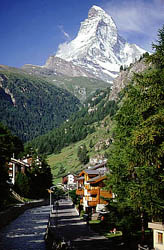 |
| The El Primero is considered among the
very best chronograph movements in existence. It is the
only movement with a fast 36,000 alternations/ hour.The
Elite automatic movement, developed in 1994, is becoming
a reference for the horological world. At the time of its
launch, the professional press elected Elite as "best
mechanical movement." Due to what seems to me one of the silliest of marketing regulations, Zenith is at the moment not allowed to sell watches in the US (they share the name with Zenith electronics, and I suppose consumers could get confused when they want to buy a TV and end up with a watch instead). |
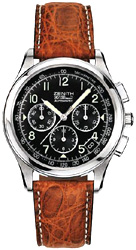 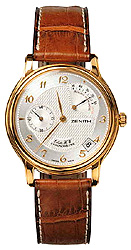 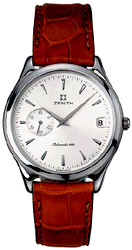 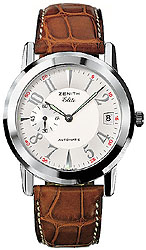 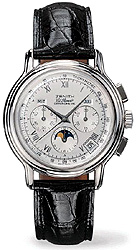 |
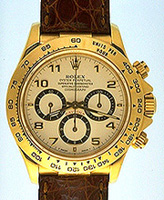 |
Zenith belongs to the unsung heroes of Swiss watchmakers, and it is perhaps the saddest case of neglect, because their watches are superb! The majority of Rolex owners might not even be aware that it is a Zenith heart that beats in their precious Rolex Daytona. Yet, in a stunning announcement, Rolex made it known in 1998 that they would no longer use Zenith's El Primero movement in the Cosmograph/ Daytona (picture on left). It was all the more stunning, because Rolex stated that they wanted to improve on the quality of the Zenith movement, which is generally respected as among the best mechanisms in any watch. | 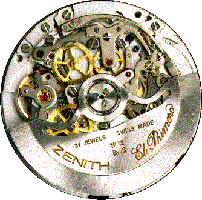 |
 |
Rolex showed the new Daytona with in- house mvt. at Basel 2000, and we’ll see! Above is a representative showing of the Zenith line, from the remarkably understated chronograph on the left to the magnificent triple date moonphase chrono on the right. Second from left is the new chronometer with power reserve, second from right a member of the new, absolutely beautiful Port Royal line. As for the square version on the right, well, some days I really like it, some days I don't. | 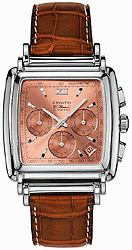 |
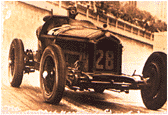 |
An equally puzzling case of neglect is that of the Eberhard Watch Company. Georges-Emile Eberhard founded the Manufacture Suisse d'Horlogerie Eberhard & Co in 1887 in Chaux-de-Fonds. |
|
| Thus begins a fascinating story, illuminated by the talents and passion of the founder, his sons and their successors. Constant effort and keen intuition guided the company to an enviable series of technical innovations in the illusive quest for perfection. In 1919, Eberhard & Co. presented the most advanced wrist-chronograph of its time, and in 1935 marketed a two-button chronograph. This evolution continued over the years, up to the latest collections of watches. Replica, a hand-wound mechanical chronograph, is inspired by a model that Eberhard & Co. furnished to the officers of the Italian Royal Navy in the 30's. | ||
|
|
|
| In 1992, Eberhard & Co. launched the Tazio Nuvolari collection to honor one of the legendary car-racer of the past, on the 100th anniversary of his birth. |
 |
Among their models are some large-sized watches such as the Traversetolo (43mm) on the left, with transparent back in the middle, and the Tazio Nuvolari Rattrapante "Geant" (51mm!). In 1997, they marketed the "8 Jours" on the right, with a power reserve of 8 days, which according to their information is achieved through 2 mainsprings with a total length of 1.5 meters. What they neglect to mention is that it apparently takes considerable amounts of time and finger strength to wind this piece, although fellow TIMEZONER Richard Smith informed me that the winding is very smooth. He also made me turn green with envy by comparing it with the action of some of his other watches. I will refrain from mentioning the models in his collection here to spare you the experience of a color change! | 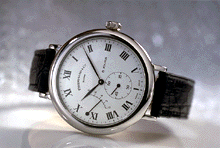 |
| The consequences for the population of the new Germany were immediate, and not all of them as positive as had been envisioned. Newly gained freedom for the inhabitants of what used to be the DDR did not bring immediate prosperity, but an explosion of the unimployment rate, a surge of mutual resentment and racism, and nostalgia for a past that all of a sudden seemed less grim than it had appeared before. It will probably be only the next generation that will see a truly united country in the context of a united Europe. One sector that benefited immediately from the fall of communism was the watch industry. It seemed as though this sector had just been waiting for the signal to explode out of the starting blocks. In an upsurge that is reminiscent of the Japanese burgeoning in the late 60s and 70s, there were suddenly German watches all over the place, and many of them in elevated price ranges. |  |
| NOMOS is Greek for "law and order," which might be a metaphor for a timepiece's nature and function. Founded in 1906 at Glashütte, Germany, NOMOS GLASHÜTTE was forced into closure a few years later because of legal quarrels. After the German reunification, Nomos was re-established in 1992 and is now manufacturing a small collection of mechanical hand-wound watches. Designed in the famous Bauhaus tradition by the German graphic designer Suzy Günter, they have that old fashioned look that Eastern German/ Glashütte products are becoming known for. |
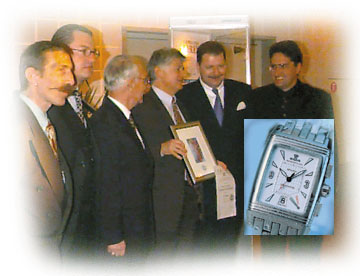 Jaeger LeCoultre, Glashütte, and Lange in the winner circle at the presentation of the "Watch of the Year" at Basel 99. |
1999 marked the sixth time
that at the World Watch, Clock and Jewellery Show in
Basel, the title of the "Watch of the year" was
awarded. This year, the winners reflect a new direction in taste and style with "newcomers" like Nomos and Sinn making it into the top 10 - note also that four of the top five are German companies: 1. Jaeger
LeCoultre - Reverso Gran-Sport |
| Page 1: hello |
Page 2: nice things |
Page 3: Audemars Piguet |
Page 4: IWC, JLC |
Page 5: Patek Philippe |
| Page 6: Flieger |
Page 7: more Flieger |
Page 8: Zenith, Eberhard |
Page 9: chronographs |
Page 10: big money! |
| Page 11: mo' money |
Page 12: more chronos |
Page 13: less known gems |
Page 14: moonstruck |
Page 15: pictures & links |